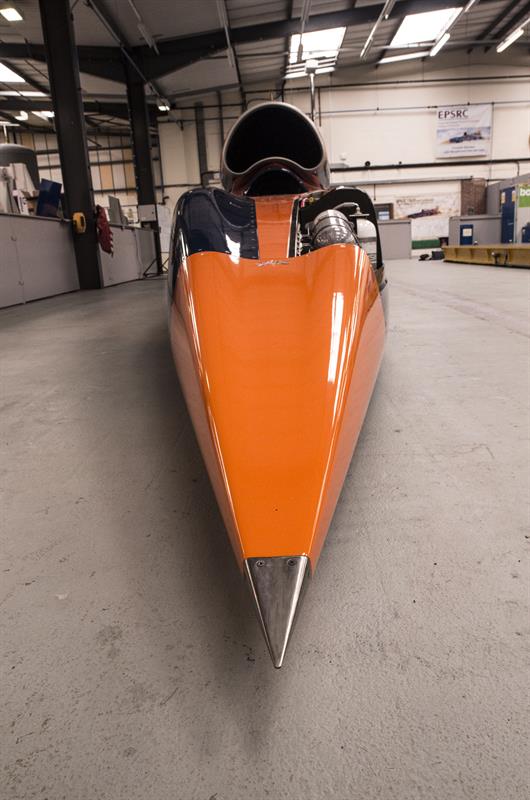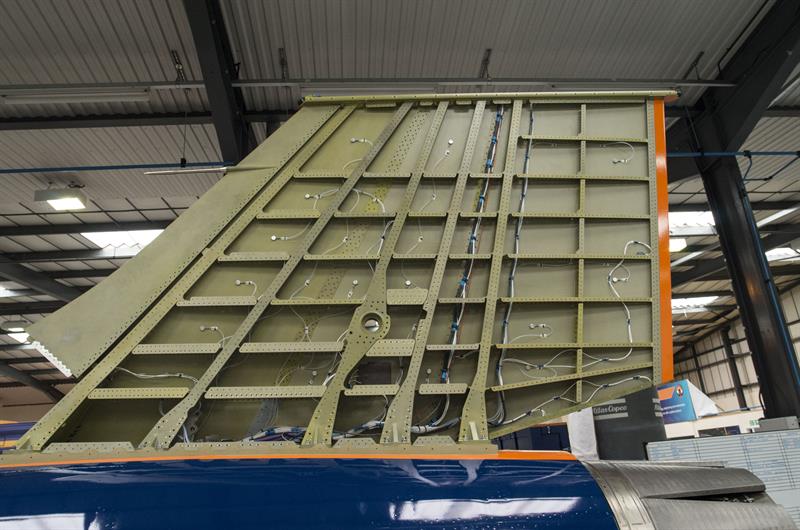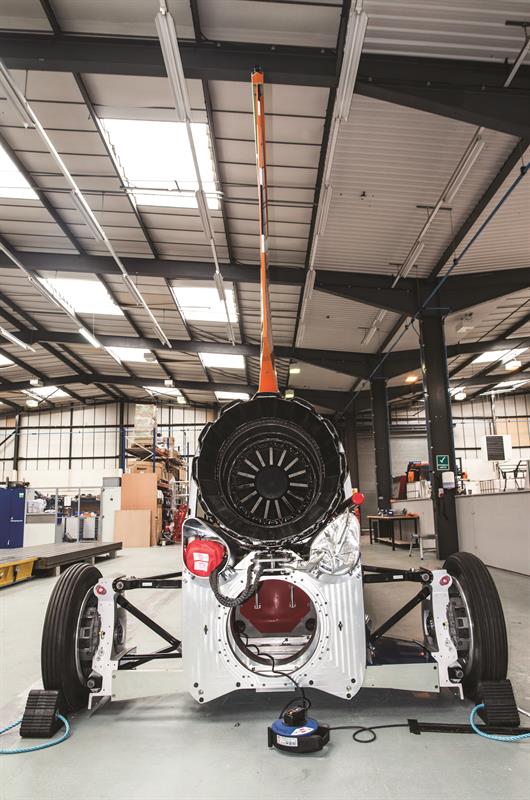The figures are astronomical. An on-board fighter jet and three space rockets, boasting combined 135,000 thrust horsepower, will hopefully propel fighter pilot Andy Green to speeds of greater than 1,000 mph, breaking the current land speed record of 763 mph held by predecessor Thrust SSC (supersonic car) set in 1997.
That goal is now farther off than expected: the second-year runs in the Northern Cape of South Africa have been put back, to at least 2018, to allow more time for raising essential funds. But the good news is that the car is now mostly together, following major assembly operations last year, and visitors to MACH were able to see its size and shape up close at the show car exhibit. UK trials will begin later this year, with the first 800 mph trial in 2017. Machinery saw the near-complete test car first-hand at Bloodhound HQ in Bristol in October 2015.
The orange and blue paint on the smooth skin of the pencil-shaped 13 m-long vehicle conceals the vast array of different materials used inside. Like an F1 car, the cockpit area is a composite monocoque. Also composite is the spine that makes up the front of the car, though both ride on top of aluminium frames and aluminium front suspension. Fastened below the composites on the undersurface of the car is a titanium floor that resists erosion from the desert sand kicked up by the front wheels and the supersonic pressure wave. The back of the car is more like an aircraft, featuring a 2 m-high tail fin. The rear is made of titanium stringers and titanium skin fastened to aluminium frames, with steel panels to protect the underside of the rear of the vehicle.

Vehicle nose 3D printed in titanium by Renishaw
Much of the car’s design is based on established motorsport and aerospace designs and materials that are well understood. As Conor La Grue, engineering lead – commercial and product sponsorship lead puts it: “We’re stacking knowns to solve a difficult unknown.”
There are some 6,000 parts in the car; of them, only the minority are standard industrial parts bought off the shelf: bearings, spacers, washers, fittings, rivets and connectors. And engines; the largest series-production parts of the car are the various means of propulsion: the EJ200 jet from the Eurofighter Typhoon jet; the supercharged petrol V8 engine from Jaguar to drive liquid oxidiser to the rocket; and the rockets themselves, now being developed by Norwegian company Nammo.
BESPOKE PART MAKERS
The rest of the parts, some 3,500, are bespoke parts. Getting them made at all was challenging, says La Grue: “There were no easy bits. Every part has a story; every bit has been difficult. That’s before you add in the element of getting stuff done for free or sponsored or for the lowest possible cost. Very high performance, uncompromising high quality and short lead times don’t normally come low-cost or free.”
He says that his original budget for building the car was zero pounds; he didn’t have any spending cash for the first two years of the project, but the project has now raised – and spent – £20 million in in-kind support; beyond that, car parts and support hardware have cost only £2.7 million.
States La Grue: “All of those companies did it because it was the right thing for them to be involved. They’ve made components, they’ve showcased their manufacturing prowess on a global stage. And it’s a remarkable tool for marketing, but it’s the open-source nature of the project that’s most important.”
The job of making components for the car was broken up into dozens of individual projects, each of which involved a small syndicate of suppliers working together. Some 340 companies signed up to be product sponsors that manufactured components; adding in other suppliers brings the total to about 1,000, of which “probably 90%” are UK value-add, he points out.
And the unit quantity ordered from most of these suppliers was one. Partly for budget reasons and partly because Bloodhound was allowed to cherry-pick the best material from suppliers such as ThyssenKrupp, Smiths High Performance and Alcoa Kitts Green, suppliers had little margin for error. Underlines the Bloodhound man: “We’ve given them a really good billet, but we want the component to be right first time.”
And yet the project’s rejection rate has been less than 1%. Adds the supply chain manager: “In an aerospace environment, you’d want to make three or four articles before you made a first-off for a fighter jet. This goes way beyond speeds, loads and energy in a fast fighter jet, and pretty much every component in the car is a first article, so that’s down to the quality of software for programming, the [skill of the] programmers and the way that they have been trained, and of the operators cutting the billets on the machines.”
In particular, PowerMILL from Delcam (0121 766 5544) was used by India-UK supplier Jaivel to develop part NC programs for the gearbox, lower and upper chassis, the front suspension subassembly and tailfin spars – some 50 parts in total. Says company managing director Vipul Vachhani: “We are providing programs to various suppliers to the project and often don’t know exactly which machine will be used until quite late in the process. Post-processing in PowerMILL is both quick and reliable, so we can cope with last-minute changes quite easily.”
La Grue visited every potential product sponsor, providers of in-kind support that included subcontractors, to verify their confidence and capability, as he explains: “So many of these are one-offs, you can’t have somebody saying, ‘Yeah, I think I can make that.’” He even made site visits to suppliers who won competitive contracts, rather than donating them.
A related issue was lead time, particularly for large parts that might need to queue up to be cut on large 5-axis machines. Says La Grue: “We haven’t wanted to wait, so we’ve worked with some partners to provide access to machines that are not as busy.”
A good example was at the Nuclear AMRC, whose workshop team and two machines were so new that there was no waiting time required. The organisation ended up cutting seven parts for the car’s rear sub-frame assembly that holds the rocket engine in place, using an HEC1800 from Starrag (0121 359 3637) and Hermle C60 (Geo Kingsbury, 023 9258 0371).
 Stringers in tail with skin removed; these long, thin parts proved challenging to machine
Stringers in tail with skin removed; these long, thin parts proved challenging to machine
Some of the large parts proved to be extremely hard to cut, he points out, referencing the experience of Manchester subcontractor Manufax, a Delcam customer, cutting aluminium 7075: “For some of these [tailfin] spars you’re talking about 60 days on the machine; and that’s spindle time.
At the end, only 2% of the original material is left, the rest becomes swarf.” The challenge of making a long and thin component from a large billet – with a tight tolerance on twist and bend required by Bloodhound chief of aerodynamics Ron Ayers – is not as simple as programming and cutting. “Even though they are the best billets we could get a hold of, with the best linear grain characteristics, you can’t take that much material out of it without it wanting to bend. We’d do a rough cut, take it off, let it rest, scan it on the CMM, rewrite the program, recut the blocks to hold it and then cut from what was there.” This hugely laborious process was then repeated, time and again, until the parts were finished.
Some parts have changed as the design of the car has matured over the past seven years: for example, the titanium nose tip, made by Renishaw using additive manufacturing, is now held on to the car with not only a bonded but also a fastened connection because of the team’s understanding of how great the forces would really be at the tip. Explains La Grue: “We didn’t have a finished design for the whole car in one go. We’ve been making parts for the car for more than five years.”

The rear of the car. Wheel farings have yet to be added, as has the rocket assembly (lower central aperture)
And some haven’t been completed yet; the rear wheel farings, for example, that feature a horizontal spike at front and rear. They will consist of a two-part leading aluminium machining, a trailing composite component, with inner titanium linings.
The team is waiting on early test runs for data on aerodynamic drag that will inform the parts’ final design.
SPINNING TRIALS
Inside those farings, and also at the front, are the vital wheels, which, at maximum speed, spin at 10,500 rpm; that’s something like 175 times per second. During the run, radial forces of 50,000 G will be acting at the rim of the desert trial wheels. They were bespoke forgings of solid aluminium 7037 made at Otto Fuchs in Germany. Back in the UK, Glasgow-based Castle Precision finish machined the wheel, and then it was tested at speeds up to 1,100 mph on a spin rig at Rolls-Royce. Says La Grue: “The test was about validating our computer model to make sure the real wheel behaved the way it did in a theoretical environment. And that also proved out the manufacture of the wheel, because it did behave.”
There were relatively few problems during assembly last year, he reports, saying: “We’ve tripped up over ourselves a few places where it goes together beautifully on the CAD, but with human beings putting it together it’s been a challenge. There are some bits of the car that are more difficult to maintain than we’d like, but when you look at the loads, with air pressures up to 10 tonnes/m2, and the [car’s] reactions and how it has to go together, it was unavoidable.”
But all of the work so far has been worth it for La Grue, who describes the process of assembling such a complex supply chain as “fascinating”. And he concludes: “It’s not a question of if we’ll get a record – we’ll get a record with this car – but will we get to 1,000 miles an hour. This next-generation car is so far beyond what Thrust SSC was. This is the ultimate land vehicle in human history, by a long way.”
Box
PUMP UP THE VOLUME
One of the trickier components on the Bloodhound car – and that is saying something – is the rocket oxidiser pump that, powered by the Jaguar V8, feeds the burn of the rocket’s solid fuel. At a key point in the record-seeking car’s run that’s as much as 40 l/sec.
For example, La Grue had a hard time finding a company that would write a cutting program for the pump’s crucial rotating part, the impeller, as he explains: “A lot of big companies in the UK didn’t want to touch it because it was so difficult. Don’t forget that these are really tiny [production] volumes. A small motorsport company in the UK ended up solving it: Loranca Engineering.”
The next step was to source the materials that it would be made from. Here again there was a problem. “The challenge with hydrogen peroxide is that all of your components have to be passivated, and you end up using quite pure stainless steels and aluminiums, which tend to be very soft,” he adds.
A way forward was found by AMRC head of advanced structural testing Phil Spiers who suggested a new aerospace stainless steel. He procured a sample from supplier Maher, and worked with Bloodhound to test it. Results on the material look promising, paving the way for manufacture of the project’s third version of the pump. Another problem sorted.
This article was originally published in the April 2016 issue of Machinery magazine.




